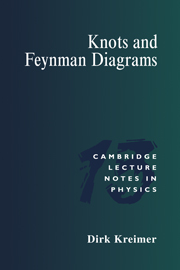Book contents
- Frontmatter
- Contents
- Acknowledgements
- 1 Introduction
- 2 Perturbative quantum field theory
- 3 The Hopf algebra structure of renormalization
- 4 Rationality: no knots, no transcendentals
- 5 The simplest link diagrams
- 6 Necessary topics from knot theory
- 7 Knots to numbers: (2, 2n – 3) torus knots and ζ(2n – 3)
- 8 One-loop words
- 9 Euler–Zagier sums
- 10 Knots and transcendentals
- 11 The four-term relation
- 12 Hopf algebras, non-commutative geometry, and what else?
- References
- Index
3 - The Hopf algebra structure of renormalization
Published online by Cambridge University Press: 04 August 2010
- Frontmatter
- Contents
- Acknowledgements
- 1 Introduction
- 2 Perturbative quantum field theory
- 3 The Hopf algebra structure of renormalization
- 4 Rationality: no knots, no transcendentals
- 5 The simplest link diagrams
- 6 Necessary topics from knot theory
- 7 Knots to numbers: (2, 2n – 3) torus knots and ζ(2n – 3)
- 8 One-loop words
- 9 Euler–Zagier sums
- 10 Knots and transcendentals
- 11 The four-term relation
- 12 Hopf algebras, non-commutative geometry, and what else?
- References
- Index
Summary
Feynman graphs are a shorthand notation for analytic expressions. These expressions are given by integrals which diverge when various combinations of internal momenta tend to infinity. The precise determination of the combinations is performed with the help of power counting. Each one-particle irreducible (1PI) subgraph obtains a weight which is its degree of divergence. By definition, such a graph cannot be divided into two disconnected components by removing one of its edges. For each divergent subgraph we need a compensating counterterm. Such a setup is actually not restricted to Feynman graphs. Any analytic expressions which have similar properties under power counting should be renormalizable by the construction of Z-factors in the same iterative manner as Feynman integrals. This is indeed so, and enables us to consider toy models as very useful tools to study the typical properties of renormalization. The step to real life pQFT is easy, once we have understood the universality of the algebraic procedure which is called renormalization.
Preliminaries
To get acquainted with renormalization at a more detailed level we will start by considering the case of purely nested divergences. We start with a simple toy model. It contains only nested subdivergences. We will slowly generalize this, incorporating all other possible configurations of subdivergences. Ultimately, we will learn that renormalization corresponds to the calculation of an antipode in a Hopf algebra.
Let us start by considering the following series in a parameter ħ, where again we iterate a logarithmically divergent series f in terms of itself and another given series K.
- Type
- Chapter
- Information
- Knots and Feynman Diagrams , pp. 36 - 96Publisher: Cambridge University PressPrint publication year: 2000



